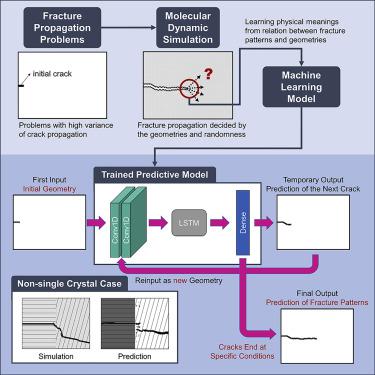Matter ( IF 17.3 ) Pub Date : 2020-05-20 , DOI: 10.1016/j.matt.2020.04.019 Yu-Chuan Hsu , Chi-Hua Yu , Markus J. Buehler

|
Fracture is a catastrophic process whose understanding is critical for evaluating the integrity and sustainability of engineering materials. Here, we present a machine-learning approach to predict fracture processes connecting molecular simulation into a physics-based data-driven multiscale model. Based on atomistic modeling and a novel image-processing approach, we compile a comprehensive training dataset featuring fracture patterns and toughness values for different crystal orientations. Assessments of the predictive power of the machine-learning model shows excellent agreement not only regarding the computed fracture patterns but also the fracture toughness values and is examined for both mode I and mode II loading conditions. We further examine the ability of predicting fracture patterns in bicrystalline materials and material with gradients of microstructural crystal orientation. These results further underscore the excellent predictive power of our model. Potential applications of this model could be widely applied in material design.
中文翻译:

使用深度学习预测结晶固体中的断裂模式
断裂是一个灾难性的过程,其理解对于评估工程材料的完整性和可持续性至关重要。在这里,我们提出了一种机器学习方法来预测断裂过程,将分子模拟连接到基于物理的数据驱动的多尺度模型中。基于原子建模和新颖的图像处理方法,我们编译了一个综合的训练数据集,其中包含针对不同晶体取向的断裂模式和韧性值。对机器学习模型的预测能力的评估表明,不仅在计算的断裂模式方面,而且在断裂韧性值方面,都具有极好的一致性,并且针对模式I和模式II的加载条件进行了检查。我们进一步检查了预测双晶材料和具有微结构晶体取向梯度的材料中断裂模式的能力。这些结果进一步强调了我们模型的出色预测能力。该模型的潜在应用可以广泛地应用于材料设计中。









































 京公网安备 11010802027423号
京公网安备 11010802027423号